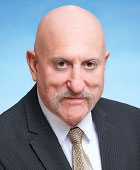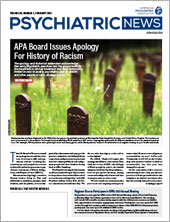You can be completely right, and you still are going to have to engage folks who disagree with you. ... So don’t try to shut folks out, don’t try to shut them down, no matter how much you might disagree with them.
—Barack Obama
Near the end of the 19th century, leaders of APA (then the American Medico-Psychological Association) asked S. Weir Mitchell, the most prominent American neurologist of that era, to address them at the Association’s 50th Annual Meeting, which was held in Philadelphia in 1894. Mitchell was reluctant to do so and clearly expressed this to the Association. Mitchell thought the 50th anniversary was a “birthday” where “pleasant” remarks should be made; he knew what he would say would not contribute to that mood. APA leaders persisted. Mitchell delivered his address.
The contents of Mitchell’s remarks were far from what those in attendance had expected. Mitchell provided a scorching criticism of the Association and of asylums. Mitchell criticized how the asylums were run, highlighting: “[W]e do not believe you are so working these hospitals as to keep treatment or scientific product on the front line of medical advance.” In this vein he stated, “Want of competent original work is to my mind the worst symptom of torpor the asylums now present.” Mitchell reprimanded the Association for its lack of engagement with residents and its low standards in recruiting junior psychiatrists. He tore apart psychiatry’s belief in moral therapy: “I think asylum life is deadly to the insane” and labeled asylums quasi-prisons.
Mitchell questioned the extent to which asylums had locked doors, barred windows, and used restraints. He found the staff lacking in training and skills, particularly the nurses. He expressed concern about the asylum’s governing board and the lack of medical authority beyond the superintendent. A function he thought that APA had “totally failed to fulfill” was “to preach down the idea that insanity is always dangerous, to show what may be done in homes or by boarding out the quiet insane, and to teach the needs of hospitals. …” He thought the members of the Association were too isolated and insulated in their work.
Mitchell offered the Association a plan of correction, which he laid out in some detail by describing his “ideal hospital.” Mitchell urged asylum psychiatrists to have outside consultants as a “good prophylactic against the inertia fed by the amount of hopeless cases that surround you.” He urged members to “try not to be merely hurt or disgusted” by what he said. He hoped his words would “bear fruit of good.”
It’s not hard to imagine how APA members felt as they listened to Mitchell challenge so many of their assumptions about their own work. APA and its members have accomplished much of what Mitchell said was lacking somewhat over a century ago, albeit after a protracted delay, where defensiveness apparently had the upper hand.
APA has a different challenge now—addressing racism in APA and in psychiatry, and the last thing we need is defensiveness (see
"APA Board Issues Apology for History of Racism"). It is apparent that we are not immune from fear of open exchanges about racism; we appear to be enmeshed in that fear. We—all of us, the experts in communication—seem to be fumbling some of our opportunities. This raises a fundamental question: What is safe for us to talk about now within APA?
That is not to say APA is not doing considerable work to address structural racism throughout psychiatry since George Floyd’s death turned the nation’s attention to racism in new ways; more recently, the death of Walter Wallace Jr. confronted us once again with the contemporaneous effects of race, mental illness, and police brutality.
At all levels of APA changes are being instituted. Recently, the Board of Trustees assigned itself the process of annual self-education and chose racism as this year’s topic; this is a new initiative and the result of a previous Board consultation. I created the Task Force to Address Structural Racism Throughout Psychiatry, which has done remarkable work to date. The task force has or will be making recommendations to the Board of Trustees to improve the racial sensitivity and inclusiveness of the Bylaws; Operations Manual; and functioning of the Board of Trustees, the Assembly, and the components. For more information about the task force, I refer you to its webpage at psychiatry.org/taskforce and encourage you to watch the task force’s town halls held to date, also available at psychiatry.org/taskforce.
The Assembly has attended to racism and its district branches on their own initiatives, and they are actively making changes—I highlight Area 1’s modifications to how it will conduct its meetings (see
Psychiatric News). The councils are also addressing racism; for example, the Council on Children, Adolescents, and Their Families has written a guidance document on how psychiatrists can talk with patients and their families about race and racism. In addition, three of APA’s councils—Advocacy and Government Relations, Minority Mental Health and Health Disparities, and Healthcare Systems and Financing—have begun work on an APA resource document aimed at defining anti-racism advocacy areas that APA needs to prioritize. The journals have made and continue to take major steps to ensure that they address structural racism and related issues in the studies they publish as well as ensure that their editorial boards reflect the diversity of the Association.
But that is not enough. APA needs to further our efforts, to help us create safe spaces for open, respectful dialogue within APA. And since the term “safe spaces” has been used in many different ways, I am applying this definition: an environment in which a person or category of people can feel confident that they will not be exposed to discrimination, destructive personal criticism, harassment, or any other emotional or physical harm. Or APA can aim for what is now referred to as “brave space”: Brave space because bravery is needed as learning requires not only risk but also giving up former conditions while taking on new ways of seeing things, and this is a painful process. Ground rules in brave space include agree to disagree, don’t take comments personally, change by choice, respect, and no attacks, according to Brian Arao and Kristi Clemens in “From Safe Spaces to Brave Spaces.”
Creating safe or brave spaces to talk with one another will then allow us to address identified areas for improvement that many of us don’t see and others of us don’t say anything about. Absent an ability to talk openly with each other without mitigating the fears and risks of marginalization; individual racism; us-vs.-them thinking; implicit bias; recrimination; isolation; anti-Black racism; repeat traumatization; ostracism; lack of recognition of intersectionality as between Black and LGBTQ individuals, for example; institutional racism; repudiation; assimilationist motivations; fears of top-down management; structural racism; White privilege; and fears for one’s own safety, among others, all too often we cannot move beyond getting mired in process to focus on outcome. If we cannot activate safe/brave spaces, all our plans, I fear, may be for naught.
To this end, APA is working through consultation from outside experts to assess all areas of APA to identify where structural racism and its effects exist. The consultants are performing the task of assisting those aspects of APA not addressed in other fora, including the Board and APA administration and staff, to achieve meaningful examinations of racism and to interface with the changes already being made throughout APA, including those led by the task force. For this initiative to be successful, we will all need to talk in respectful, constructive ways about how structural racism affects us and to make changes in our own behaviors.
The results of the assessment may well be as hard to receive as it was for our predecessors to hear what Mitchell had to say. APA leadership needs to lead the process, to be open to the results of the assessment and act in good faith as parties in a plan of correction. But then we all need to ask ourselves, “How much vulnerability am I willing to tolerate to do this work?” “Can I trust that this process of change will not repeat past declarations of change when no real change occurred?”
If we are going to eradicate racism within APA, we must change ourselves. To get sustainable change, we should expect a period of disruption as we progress to authentic interactions. APA is an organization of us—so we need to do the work. If we succeed, APA and psychiatry will benefit immeasurably. ■
“From Safe Spaces to Brave Spaces” is posted
here. It is a chapter in the book
The Art of Effective Facilitation.

